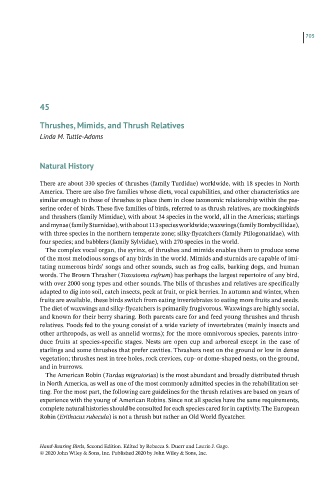Page 703 - Hand rearing birds second
P. 703
705
45
Thrushes, Mimids, and Thrush Relatives
Linda M. Tuttle-Adams
Natural History
There are about 330 species of thrushes (family Turdidae) worldwide, with 18 species in North
America. There are also five families whose diets, vocal capabilities, and other characteristics are
similar enough to those of thrushes to place them in close taxonomic relationship within the pas-
serine order of birds. These five families of birds, referred to as thrush relatives, are mockingbirds
and thrashers (family Mimidae), with about 34 species in the world, all in the Americas; starlings
and mynas (family Sturnidae), with about 113 species worldwide; waxwings (family Bombycillidae),
with three species in the northern temperate zone; silky‐flycatchers (family Ptilogonatidae), with
four species; and babblers (family Sylviidae), with 270 species in the world.
The complex vocal organ, the syrinx, of thrushes and mimids enables them to produce some
of the most melodious songs of any birds in the world. Mimids and sturnids are capable of imi-
tating numerous birds’ songs and other sounds, such as frog calls, barking dogs, and human
words. The Brown Thrasher (Toxostoma rufrum) has perhaps the largest repertoire of any bird,
with over 2000 song types and other sounds. The bills of thrushes and relatives are specifically
adapted to dig into soil, catch insects, peck at fruit, or pick berries. In autumn and winter, when
fruits are available, these birds switch from eating invertebrates to eating more fruits and seeds.
The diet of waxwings and silky‐flycatchers is primarily frugivorous. Waxwings are highly social,
and known for their berry sharing. Both parents care for and feed young thrushes and thrush
relatives. Foods fed to the young consist of a wide variety of invertebrates (mainly insects and
other arthropods, as well as annelid worms); for the more omnivorous species, parents intro -
duce fruits at species‐specific stages. Nests are open cup and arboreal except in the case of
starlings and some thrushes that prefer cavities. Thrashers nest on the ground or low in dense
vegetation; thrushes nest in tree holes, rock crevices, cup‐ or dome‐shaped nests, on the ground,
and in burrows.
The American Robin (Turdus migratorius) is the most abundant and broadly distributed thrush
in North America, as well as one of the most commonly admitted species in the rehabilitation set-
ting. For the most part, the following care guidelines for the thrush relatives are based on years of
experience with the young of American Robins. Since not all species have the same requirements,
complete natural histories should be consulted for each species cared for in captivity. The European
Robin (Erithacus rubecula) is not a thrush but rather an Old World flycatcher.
Hand-Rearing Birds, Second Edition. Edited by Rebecca S. Duerr and Laurie J. Gage.
© 2020 John Wiley & Sons, Inc. Published 2020 by John Wiley & Sons, Inc.

